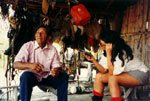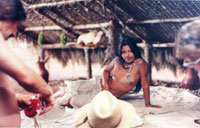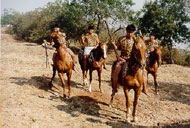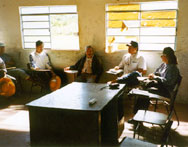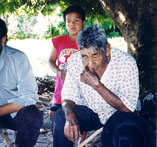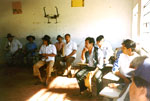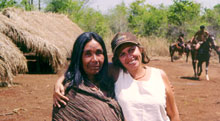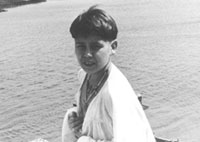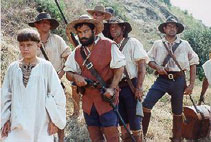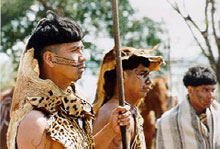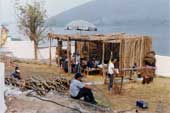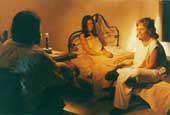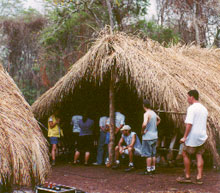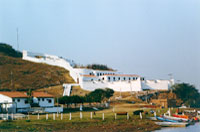|
(Based on a statement by L˙cia Murat) The idea of making this movie back dates to the late 1980s, based on an old military report I was given on the Coimbra Fort. In four or five sentences, it outlined real-life events involving the Guaicuru tribe, describing a kind of Trojan Horse event which took place in Brazil during the late XVIII century in the depths of the Pantanal wetlands. I was fascinated by this tale, which reshaped the usually submissive image the indigenous peoples of Brazil. Suddenly, I found myself faced with warriors on horseback, their bodies painted with fantastic designs. I was given this military report to make a documentary, but I immediately realized that this was the basis of a fiction movie based on facts that I really wanted to make one day. In early 1997, I had just returned from Berlin with Doces Poderes and a producer asked me if I had any projects in the pipeline. This unleashed the entire process that resulted in Brava Gente Brasileira I traveled to the Pantanal wetlands to investigate this four-line historical footnote. During my research, when I visited the KadiwÚu indigenous reserve for the first time, the movie began to take on fresh proportions with the history of the settlement and colonization of this region and the incredible history of the Guaicuru tribe and its descendants: today's KadiwÚu.
After this initial field trip, I began to work on a story-line whose idea was to contrast these two cultures. Highlighting the impossibility of them ever meeting, I decided to introduce a character - Diogo - to represent the best of European culture at that time, in this case a somewhat Rousseau-like man influenced by the Enlightenment but who would nevertheless prove unable to deal with these differences. Right from the start, I wanted this character to be Portuguese, played by a Portuguese actor, with this choice later falling on Diogo Infante. In fact, what prompted me to make this movie was the challenge of focusing on the issue of the difficulties involved in relating to others. In terms of aesthetics as well as the actual script, we sought a path that would lead us in this direction. I did not want to make a traditional period movie. What is a traditional period movie? It is a film that is more institutional, with a more institutional relationship to history itself and the way that history is recounted. This is why we decided to use a hand-held camera and shoot in Super-16, offering greater agility, all in an attempt to recreate the unwashed world of the XVIII century in Center-West Brazil in an artless manner. But the most important decision of all was to work with the KadiwÚu tribe, playing their own forefathers: the Guaicuru.
The idea was to spotlight the differences between these two worlds. And as the KadiwÚu performed, both their gestures and speech began to portray a different way of being. This is why we undertook a broad-ranging survey (shot in High-8) in the indigenous reserve, with all the tribal elders. We then selected the cast and started to shoot a month later in Bodoquena, a small town near the reserve. Coordinated by actor Murilo Grossi, the selected tribespeople served as a laboratory, performing with actress Luciana Rigueira, who was the only professional playing an indigenous woman, with the remainder of the tribal roles played by the KadiwÚu themselves.
This led us along a path running counter to the standards of Hollywood and the traditional structure of a fiction movie. Instead of seeking European actors who looked like tribespeople to play the villagers, we allocated our budget to casting producers and linguists, investing in research and working closely with members of the community so they could make their contributions to the movie. But it is also clear that, despite all this research the definitions were not exhausted in the laboratory. To certain extent, we lived through everything portrayed in the film during the daily shoots, with all the head-on cultural clashes of these two worlds. I think that the most difficult part of the film was working with a fictional story-line, while at the same time attempting to build up this real-life dialog with an indigenous culture. This meant that no matter how solidly the script was based on information from the tribespeople themselves, it necessarily ran through my own European filter as well as those of the other people working with me on this project (SÚrgio Flaksman, Luiz Eduardo Vidal and the consulting facilities of the Sundance Institute).
There were many moments during shooting when I became quite desperate watching the tribespeople playing a scene based on our research and realizing that it rang false as our European filter had prevailed. A very clear example of this was the waterfall scene, which was later cut. This take showed a group village youngsters going to a waterfall. When I began to shoot, what was my own experience of going to a waterfall? I used to go to Ipanema beachů so I looked at the girls and watched what they were doing, and the feeling I had was that they were strolling off to Ipanema beach. This discovery of a false note, this discovery of the existence of my own filter, and my attempts to reach something closer to the truth were the major challenges of this movie. And I think that if we manage to deal with them, it was obviously through a tremendous efforts on our parts, with the eager cooperation of some of the tribespeople playing a vital role, particularly Aracy and Hilßrio Silva, who managed to build bridges between these two cultures.
There was a joke among the crew that this was - quite contradictorily - a film of both the process and the system. When I asked Aracy for some explanation of the details of rituals or conduct, she generally answered me that this was the "system" that I should obey. On the other hand, I was constantly tinkering with our shooting schedules and the actors' marks (both indigenous and European), claiming that the film was a "process" of learning about this nature, this culture and the clashes reflected in the situations portrayed. Perhaps the most outstanding example of this "process" was the introduction of the character played by Dilsinho (Adeilson Silva) as the kidnapped white boy.
Some three or four months before we started shooting, with the script in its sixth rewrite and having already run it through the Sundance Laboratory, I once again visited the indigenous reserve and stayed at the home of a young woman (Sandra Silva, who was to play the role of AnoŃ's mother in the movie) who I had not met before. Suddenly, a blond light-skinned lad walked in, talking KadiwÚu. We (I was with my assistant, Rodrigo Hinrichen) immediately asked "Who's this?" The boy was a half-caste, Sandra's son with a man from Southern Brazil - home to waves of Northern European immigrants. We were immediately enchanted, as the boy had incredible charisma and moved easily between the two cultures, speaking fluent Portuguese and KadiwÚu. But the most interesting aspect was the apparent contradiction between his European appearance and his great pride in being KadiwÚu. When we met, I thought: "Good heavens, if I had written this character into a script I would never have found this young actor." There was a character in the original script - a white woman kidnapped as a child by the tribe - who later developed a relationship with Pedro, the character played by Floriano Peixoto. Right then, I had the idea of replacing this kidnapped girl by the boy, which would mean sweeping changes in the story-line as all the sexual issues highlighted by her relationship with Pedro would have to be excised or turned into something else. But it was quite irresistible. So we decided introduce the character of Dilsinho, based on this lad. And quite honestly, the educational discussions between the character of Pedro and this boy are among the best things in the movie, perhaps because these situations were created with the help of Dilsinho himself.
All this is very important in the movie, this freedom that we had to seek and search out, reflecting my documentary background. And I think it was marvelous. Anthropologist Levi-Strauss - who undertook a broad-ranging survey of the KadiwÚu during the 1930s - wrote that it was a privilege to be able to observe another culture. This feeling was very strong among us all, particularly the crew who worked most closely with the tribespeople. This feeling grew deeper over time, as we discovered our own insignificance and ethnocentrism. The anecdotes of our misunderstandings make us smile, because they highlight this privilege even today. For instance, I remember the issue of the name of Dilsinho. When I met him in the reserve, I had the impression that someone called him Dilsinho, so I started to call him by this name. As he always responded and neither his mother nor any other relatives ever made any comment, I had not the slightest doubt that his name was Dilsinho. Obviously, as the rest of the crew got to know him they also called him by this same diminutive, which better expressed our affection for him than his full name in Portuguese: Adeilson. Five months later, as shooting drew to an end, we were amazed to discover that he had never been called Dilsinho, but that as that was what I called him, he began to answer to this name, with his mother, aunt, etc. following suit without anyone ever having commented on this situation or finding it odd. Perhaps this is the key word: odd. After all, everything was odd: we ourselves, the entire film, the importance we gave to a name, our numbered identity cards, etc. For them, in an inclusive culture, it is common to change names in the course of a life-time (the KadiwÚu used to take new names in certain situations: on reaching adolescence, when a close relative dies) and they saw no reason to draw attention to the fact that this strange white woman had decided to create a new name for him. And that is where we stand with their apparently mysterious way of being. And perhaps this is the other key word: mystery. Some things that we noticed left us quite amazed (such as discovering that he was not called Dilsinho), but in essence it is almost impossible to get through. This is why we also decided not to translate the KadiwÚu lines. The dramatic situation can be understood through the images, needing no translation to understand the story, as we do not want to banalize their culture. Our idea was to maintain this strangeness, confirming this quasi-impossibility of getting through to the Other, which is the real issue discussed in this movie.
But despite our intentions and all this quasi-documentary treatment, this is a fiction movie that ran into all the tricky production problems usually encountered when making a period movie. For instance, we obliged to build a village set - which was a really tough job for the art department - as we unable to shoot in the reserve. Initially, because the reserve today looks like any outback township, with a few brick-built houses and many straw huts that recall the original huts of the KadiwÚu only remotely. Second, because the road leading to the village is very poor, and the trucks could not get through with all our equipment. Finally, because we were unwilling to "assault" the reserve with all the side effects of shooting on location. As most of the community have been in contact with neighboring towns, meaning that commuting is nothing new to them, we decided to build a village set in the town of Bonito near the reserve. One of the loveliest parts of the state, its appearance is reflected in its name: Bonito means beautiful in Portuguese. This village was built on the basis of information found in European bibliographical references and surveys carried out with tribal elders.
The more adventurous aspects of this project were prompted by the decision to shot in the Coimbra Fort where the historical events actually took place and on which our script was based. Set in the depths of the Pantanal wetlands, it is a seven-hour boat-trip from the nearest town (Corumbß) in a setting packed with birds, alligators and insects quite unknown to any urban being. Alongside the fort is an Army barracks and a small hamlet. Just getting there, gearing up to shoot and getting organized was another challenge for the production crew, coordinated by RenÚ Bittencourt, and which in fact proved possible thanks only to the infrastructure provided by the Brazilian Army.
The art department
had to deal with another challenge at the Coimbra Fort. During the
recent electrification of this region (the first few times I visited
the fort, this grid had not yet been strung) and despite the fact
that it is a heritage site, high-voltage power lines were strung all
around it, preventing us from shooting any takes from above, or showing
the location of the fort set against the river. The initial decision
- intended to preserve the links between the fort and the river -
was to film the outdoor fort scenes at Fort Junqueira in Corumbß,
which today consists only of its original outer wall. On second thoughts,
we decided to build a palisade masking the power lines and allowing
us to use the more spacious inner area of Fort Coimbra. This task
took a month and a half, but the results were excellent, as not only
did it serve its original function of concealing the power lines and
poles, but also endowed the film with an appearance closer to that
of a rustic fort under construction, as we used rough-hewn timber.
So was it all worthwhile? The answer cannot be mineů but quite sincerely,
if we have managed to portray on the screen just a small proportion
of all our experiences, I am quite certain that it was worth every
minute of effort. But the final decision is up to you ů. the
film . download files . characters
& actors . awards & festivals |
